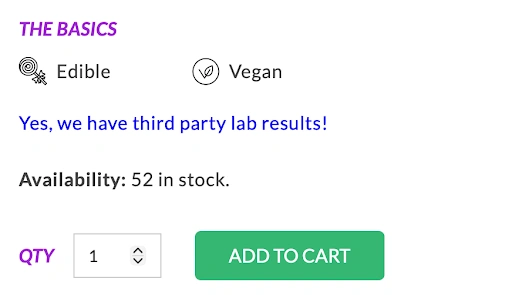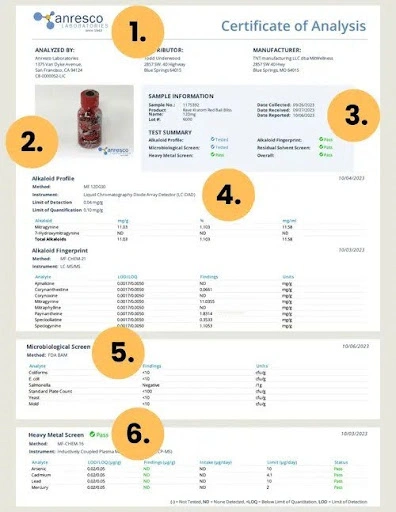
Understanding COAs for Kratom or 7OH
What do you look for in a kratom or 7-hydroxymitragynine product? Maybe potency is your priority, or maybe it’s great flavor. While shopping for your new favorite feel-good product, there’s one factor you won’t want to overlook—The Certificate of Analysis.
A Certificate of Analysis (COA) offers transparency into a given product. This important document details what’s in your tablet, capsule, powder, or shot, and in what amounts. At first glance, a COA can appear intimidating, with verbiage and numbers that you might not immediately understand. However, with a few key tools, you can easily skim a COA to find the information you need to make your purchase decision.
Let’s dig into the details, including what COAs are, what information can be found on them, and how to understand key factors. In this guide, we’ll focus on kratom and 7-hydroxy COAs. If you’re shopping for THC products, check out this blog: How to Read a COA.
Why Do Brands Offer COAs?
Brands send samples to independent lab facilities for testing, and the results of that testing are presented in a COA. Third-party lab testing can be time consuming and expensive, but it’s worth it for reputable brands to demonstrate product safety and consistency to their consumers.
COAs may look different depending on the brand, laboratory, and product type. This guide will help you identify what to look for, no matter the format.
Where To Find a COA
So a kratom or 7oh product has caught your eye. The next step is to find the COA! The document’s location may vary according to the brand. Here are three common places to look:
The Brand’s Website: Check the top or bottom of the brand’s website for their navigational menu. Look for a link that says “Certificate of Analysis” or “Lab Results.”
On the Product’s Packaging: If there is a QR code on your product, you can scan it and it will send you to the lab results for that specific product and batch. This is the best way to get the most updated lab results.
The Green Dragon CBD Product Page: Click on the product you’re curious about. Under “The Basics” there’s a link that says “Yes, we have third party lab results!” Click that link and the COA will appear.

If you can’t easily find the COA, contact the brand or retailer. They should have the updated lab results or should be able to quickly provide them.
What Information Appears on a COA?
A COA looks for and tests quite a few items in the product that are related to quality and safety, providing important benchmarks for safety and quality. Below is what the typical lab test should include:
- Identity: Confirms the identity of the product.
- Strength: Alkaloids per serving.
- Test Summary: This section will tell you what was tested and give pass/fail grades.
- Alkaloids: Tests whether the alkaloids are within legally permissible limits. The two main alkaloids in kratom are mitragynine and 7-hydroxymitragynine, but alkaloids may also include ajmalicine, corynantheidine, corynoxine, mitraphylline, etc. A test will also show total alkaloids.
- Impurities: Labs test for contamination with impurities like Coliforms, E. coli, Salmonella, Standard Plate Count, Yeast, Mold, etc. The COA will include details about the test method and include a pass/fail grade.
- Heavy Metals: Detects the presence of heavy metals like lead, mercury, arsenic, cadmium, and nickel in the product. May include a pass/fail grade.
The Vocabulary of a COA
W/W%: Stands for weight by weight percent, or the concentration of a component in a mixture, calculated by comparing its mass to the total mass of the mixture.
CFU/g: Stands for Colony-forming Units Per Gram. This is a number of living microorganisms in a solid sample. A colony-forming unit is a single cell or cluster of cells that can grow into a visible colony on a petri dish relative to a gram of the sample.
LOD: Stands for Limit of Detection, which is the lowest amount of a substance that an analytical method can detect with a high degree of confidence.
LOQ: Stands for Limit of Quantitation, the lowest concentration of a substance that can be measured accurately and reliably by an analytical method.
Specifications: The acceptance criteria for a given product.
PPB: Stands for parts per billion, a unit of measurement for low concentrations of a substance. Compares one part of a substance per one billion parts of the whole mixture.
ND: Stands for Not Detected.
<: This may be used to denote that the amount is below the limit of quantitation.
Some COAs may also include a key at the bottom of the page that will define terms.
Why It Matters
If a product does not have a COA readily available, it’s a red flag! Seriously, consumers like you have a right to know what’s going into their bodies, and reputable brands will make sure you have that peace of mind. Just like you check the ingredients on your shampoo bottle or the nutrition facts on your breakfast cereal, you should also check the COAs for kratom and 7oh.
In case you still need convincing, here’s a short list of why you should make time to skim through COAs:
- Ensure you’re getting a high-quality, effective product.
- Check if the potency suits your tolerance level.
- See what alkaloids are present in the product.
- Check for the absence of toxic materials in your product.
- Check for ingredients that you may have an allergy to.
- Make sure the product isn’t expired and the lab results are up to date.
It only takes a minute to check through the important things, so let’s move on to how to read lab results!
How to Read a COA
Reading a COA is simpler than it looks. Many COA’s contain multiple pages, but most of what you need to know is on the first page. Here is an example of how to identify key parts of a COA:
*Remember - COAs may not look the same across all brands and products, so look for the things listed below.

- Check Out The Lab: Look for COAs from third-party labs, independent labs, or labs that belong to a reputable organization.
- Up-To-Date Basic Information: Is it the right product? Many COAs will include a picture of the product along with basic information like the name, strength, and the date tested. Ideally, the test will be from within the past year.
- Sample Info & Test Summary: On the first page, the COA should describe the sample and provide a test summary. This section is great for at-a-glance information, including whether pass/fail grades.
- Alkaloids: See what alkaloids are present and in what amounts.
- Impurities: See any contaminants that are present in the sample and at what amounts. The test will tell you if the detected level of contaminant is within an acceptable range.
- Heavy Metals: The kratom plant can accumulate heavy metals from the soil and water where it grows. The test will tell you if the detected level of heavy metals is within an acceptable range.
Can’t Find a COA?
If you can’t find the lab results at all and the brand/retailer can’t help you, you should consider choosing another product. For all of the kratom and 7oh products we carry, the COAs will be on the product page. If, for some reason, it’s out of date or you can’t find it, contact us and our team will help you find the latest lab results!











